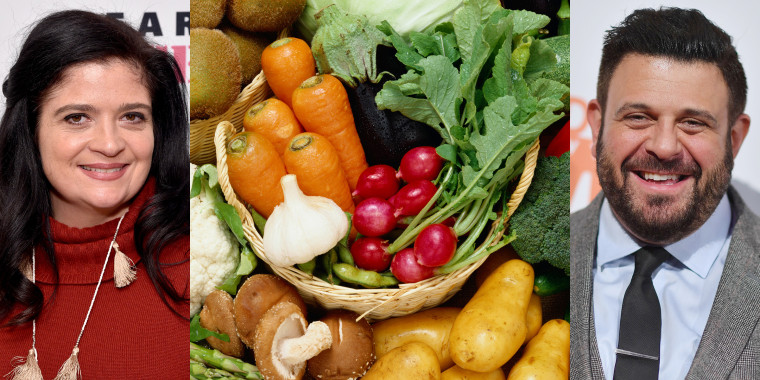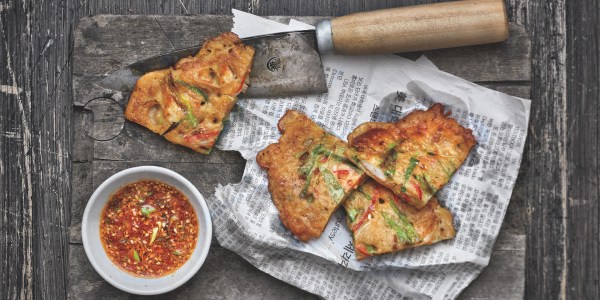Creating more sustainable habits in the kitchen is easier and more affordable than you might think — especially with the help of all-star chefs.
Shoppers often walk down overflowing aisles at their favorite grocery stores and fill their carts with superfluous goods. Many of these items have traveled miles or used up countless resources just to fall into the back of your freezer, your cabinet or, worse yet, your garbage can.
So, for this Earth Week, TODAY Food reached out to top chefs to learn how to eat well and feel good about treating the environment well, too (some tips can even save you money!).
From experimenting with “zero waste” cooking, to buying local and repurposing ingredients in inventive recipes, these chefs love to prepare delicious foods that give back to the planet.
Daniel Angerer
Daniel Angerer, the Director of Culinary Arts at Hu Kitchen who battled Bobby Flay in "Iron Chef America," practices food sustainability through creativity and a careful food-consumption forecast.
Angerer utilizes what he calls “nose-to-tail cookery,” by using every part of an animal to maximize food product and minimize waste. Hu Kitchen boosts its veggie crop in much the same way.
“We chop broccoli heads for our sautéed broccoli dish and shred the stem parts finely for usage in other dishes such as broccoli soup,” Angerer told TODAY.
Whether you’re feeding a family or running a restaurant like Angerer, it’s important to take notice of what gets eaten and what gets tossed, so be diligent in taking inventory of what it's in your fridge and freezer on a weekly basis. If you notice that you're often throwing away a lot of berries, maybe your family doesn't enjoy them as much as you think they do.
Robert Irvine
Robert Irvine, former host of Food Network's show“Dinner: Impossible,” warns against cutting up fruits and veggies before you plan to eat them.
“Once you cut lettuce and fruits and other vegetables, they will decompose quicker,” the restaurateur said. “It’s our responsibility as chefs to continue to learn our craft, and also learn how to protect our food sources.”
Irvine subscribes to Angerer’s "nose-to-tail" philosophy, too. He often buys a whole chicken and uses the bone and trimmings to make chicken broth.
Diego Garcia
Diego Garcia, the executive chef at The Four Seasons Restaurant in New York City, said he likes to use up any extra herbs or scraps.
“Sometimes, we have an abundance of herbs. With the herbs, we make oils like chive oil or chervil oil, which we then incorporate into specials,” Garcia told TODAY. “When it comes to proteins and red meat, we always save the trim and bones and use that to make sauces and stocks.”
For fish dishes, Garcia noted that some sea creatures, “like skate, tilefish and striped bass,” are more sustainable than others. These “eco-friendly” choices, according to the Environmental Defense Fund’s Seafood Sector, “come from healthy, well-managed populations, and the fishing or farming methods used to catch or raise the fish cause little harm to the environment.”
Home cooks can also seek out sustainably raised food by shopping for locally grown produce and regularly checking Seafood Watch for suggestions on ocean-friendly dinner ideas.
Alex Guarnaschelli
Food Network star Alex Guarnaschelli thinks the owner of any kitchen (big or small) can certainly do more to curb waste.
At her New York City restaurant, Butter, Guarnaschelli treats her staff to meals made “largely from leftovers or excess meats, fish and vegetables to avoid food waste.”
At home, the "Iron Chef" alum cooks with as many different seasonal vegetables and local ingredients that she can fit on a plate because, according to Guarnaschelli, “one part of sustainability is biodiversity.” Cooking with a wide range of ingredients isn’t just the spice of life, which means you'll be less likely to get bored with your meals, but being mindful of how far food has traveled to get to your plate is important.
Morgan Jarrett
Chef Morgan Jarrett, who works at Yellow Magnolia Café in Brooklyn Botanic Garden, practices “root-to-stem cooking,” where she uses every part of the vegetable.
“In the summer we have a 'zero waste' watermelon soup,” Jarrett told TODAY. “We grill the flesh, make a cream out of the rind and turn the skin into a powder. We use byproducts of things that have traditionally been thrown in the trash.”
Love chickpeas? Don't drain out all the liquid! For an easy, vegan, mayo-like spread Jarret likes to repurpose the gooey liquid drained from a can of chickpeas to make creamy aquafaba aioli. And leftover pickle juice? The chef swears it's perfect for “a brine on roast chicken or the acid component of a salad dressing."
Judy Joo
Instead of forcing new scraps into old favorites, the Cooking Channel's "Korean Food Made Simple" host Judy Joo lets leftover trimmings inspire new dishes.
“We make fantastic fried rices and savory Korean pancakes that are studded with bits of meat and veggies that just happen to be off cuts,” Joo said of her restaurant. Fried rice is an incredibly versatile dish that can be made with plenty of leftover ingredients (any extra protein, your favorite veggies, a little egg, etc.) at home, too.
When shopping for herself, the "Iron Chef UK" alum takes the time to read labels carefully. “Food shopping has become rather confusing with so many different terms and labels these days,” Joo said, noting that "what you buy is no longer just about what you like to eat, but it has become a statement impacting a number of different global issues."
For example, if animal welfare is an issue close to your heart, look for meat and egg labels that explicitly say "Certified Humane." "Free-range" and "cage-free" do not necessarily mean that the animal has unlimited space to roam.
Adam Richman
Adam Richman, best known as the Travel Channel’s “Man v. Food” host, practices food sustainability with a home garden.
“I try to use whatever scraps I can as compost in my garden. Plus, certain things like tubers or root vegetables can actually be replanted,” Richman told TODAY. “Fruit that has gone a little bit too far ‘round the bend,’ can be used for jams as well.”



